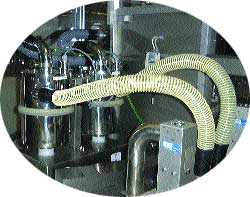January 29, 2014

In pharmaceutical packaging, sometimes 100-percent assurance is barely enough–especially when sensitive products are involved. And, this is even more at a time when security is becoming reflexive.
Taking no chances, Aventis is doubling up on a visual inspection system for a packaging line in its operation near Compiegne, France. Installed and validated more than a year ago with the system integral to its function, the 275/min blister-packaging line is operating without a hitch, PD learns from Aventis project leader Jean-Luc Helin. Validation required only two months, he says. Packaging various prescription-only oral tablets and capsules, including a high-potency analgesic, Colchimax™, and an anti-arthritic, Arava™, the line can inspect for broken or missing product and even for minor defects in the blister material. When these problems arise, product is removed automatically for repackaging, and the blister is ejected and examined for possible problems.
For major defects such as wrong product color, size or shape, the system is programmed to extract the product and stop the line. There are separate reject stations for products and defective filled and empty blisters, which are pulled off-line by vacuum.
Exceptional range
Working on the line with coated foil forming and vinyl blister components is the Master of Pharma® inspection system from Covan Vision Systems, which is highly adaptable to Aventis' changing needs.
Mounted just beyond the filling section of the IMA C90 continuous-motion blister packaging machine is the first of two illuminated stations, a CVS2020 color camera with a 640 x 240-pixel resolution for initial checking. The camera, detecting a minor defect in the blister or a missing or broken tablet or capsule, triggers instant ejection. Here, too, major defects such as oversize product or wrong color cause ejection, as well as stop the line.
|
Mounted just after filling and before sealing, cameras analyze defects qualitatively, directing rejected product and blister materials to segregated collecting trays. |
The second camera, the CVS2010, with black-and-white capability, is mounted just before the sealing station to check on correct filling of the blisters. A single empty blister will be drawn off-line into a separate reject collector. After five consecutive removals, the line automatically shuts down. Having separate trays for each type of rejection enables efficient segregation of products and material while guiding analysis of types of problems that may arise. Even so, the system stores in its memory the nature of detected mistakes and the number of times they appear during a production run.
Management simplified
Integration of the two inspection systems is managed by an industrial computer linked to two single-board slaves. With a single screen designed for human/machine interface, a lone operator is able to monitor all of the inspection functions.
As significant as the inspection equipment is to assuring product and package integrity is "the software designed to the line's specific needs," says Robert J. Fortier, a partner in AC Compacting, which represents Covan on these shores. "Because of the potential for disaster with incorrect medications or dosages, plus the high value of the products, the systems must be able to differentiate accurately and repeatedly at acceptable output levels," he says.
These levels are gaining gradually, recently reaching 275/min on an average eight-across web, Jean-Luc Helin confirms. An eventual goal is 300/min, said to be the rated output of the packaging line. This would put no strain on the inspection system, whose capabilities are reported to be far above this level. With the color camera, inspections are rated to 800/min; this increases to 1,000/min for the black-and-white version.
Meanwhile, working at current output, the blisters passing muster perfectly convey downstream to IMA's BFB cartoner for side loading into paperboard cartons, which are then end-glued and packed off.
With this experience well under control, Helin informs PD, "We're examining the possibility of adapting this inspection system for some of the other eleven packaging lines in the plant."
More information is available:
Inspection system: Covan Vision Systems, 32 56/25 99 81. Circle No. 238.
Inspection system representative: AC Compacting, 800/524-0183. Circle No. 239.
Blister machine/cartoner:IMA North America, 203/331-0331. Circle No. 240.
About the Author(s)
You May Also Like



